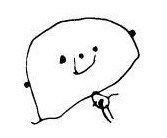This article is part of the book Secrets of Art Therapy Part One by Dr. Walid El Gandy 2025

Have you ever watched a child hold a pen for the first time? Those random lines they leave on the paper might seem meaningless to us, but in reality, they are the very first seeds of an amazing creative journey. George-Henri Luquet, one of the leading pioneers in the study of children’s art, believed that this journey isn’t just a series of passing scribbles, but rather sequential stages that reveal the development of a child’s consciousness and perception. Let’s delve together into the first two stages of this journey: incidental realism and unsuccessful realism.
(Incidental Realism (Where the story begins
In this stage, also known as “realism of chance” or “fortuitous realism,” the child has no prior intention of drawing anything specific. They are simply discovering that a pen leaves a mark on paper. The lines flow spontaneously, and then suddenly, the child sees a familiar shape in one of these lines. They might point to a circle and say, “That’s the sun! or see two intersecting lines and say,”That’s my dad
This moment isn’t just a fleeting act of naming; it’s the first spark of consciousness. The child realizes that what they draw can represent something from their real world. It’s the moment when the mind connects abstract lines with tangible meanings. It’s as if the child is telling themselves, “This random scribble can have meaning!” This ability to give meaning to what is random is the beginning of symbolic thought, which is the cornerstone of all forms of art and expression
(unsuccessful Realism (The First Attempts at Intention
After the child discovers the power of symbols in the first stage, they move on to a more challenging phase. Here, they have a premeditated intention to draw. They no longer wait to discover a random shape; instead, they decide before picking up the pen: “I’m going to draw my mom” or “I’m going to draw a cat
But the results are often disappointing! What the child draws doesn’t exactly resemble what they intended to draw. They might forget to draw hands or legs, or they might draw a body without a head. Luquet describes this stage as “unsuccessful,” not because the child is a failure, but because their mental capacity has outpaced their artistic ability. They know how something should look in their mind, but they lack the motor skills and control over the pen to turn their idea into reality
This stage reflects an internal struggle: a conflict between the mental image and the drawn image. The child faces two challenges
Mental Distraction: They think of several details at once, causing them to focus on one part and forget the others
Motoric Difficulties: They lack hand-eye coordination
These apparent “failures” are actually important steps toward mastery. Through them, the child learns that drawing requires effort and planning, and that turning ideas into visible forms isn’t a simple process. They are valuable learning attempts that teach the importance of effort and perseverance
In conclusion, our understanding of these stages changes how we view children’s drawings—from mere scribbles to a window into their developing minds. Every line and every incomplete shape is part of a unique artistic and psychological journey that deserves our respect and understanding
This article is part of the book Secrets of Art Therapy Part One by Dr. Walid El Gandy 2025
